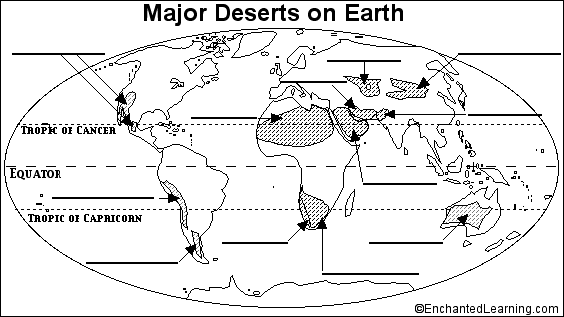|
a. What are the general characteristics of deserts?
b. What percentage of the Earth is desert?
c. Explain the differences between a hot and dry desert and a cold desert.
d. What adaptations are found in plants and animals that lives in a hot
desert?
e. What adaptations are found in plants and animals that live in a cold
desert?
- What are some threats to deserts?
- What are some solutions?
g. Color your map to show the major desert areas (you don't need to
name them).
Arabian
- covering most of the Arabian peninsula.
Atacama - running down the western
coast of South America (in Chile).
Australian - hot deserts covering
much of western and central Australia.
Iranian - northeast of the Arabian
peninsula and west of the Thar desert.
Kalahari - covering much of the
southeastern tip of Africa.
Namib - running down the
southwestern coast Africa.
North American - rain shadow
deserts in southwestern North America, in the USA and Mexico.
Patagonian - in southeastern South
America.
Saharan - a huge desert covering
much of northern Africa - the biggest desert in the world.
Takla Makan-Gobi - a continental
desert in central Asia.
Thar - in northwest India.
Turkestan - in southern Russia . |
 |

Baja, Mexico desert;
desert in Uluru National Park,
Australia
desert near the Kofa Mountains, AR
|
home |
